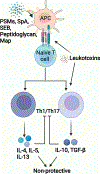Integrating complex host-pathogen immune environments into S. aureus vaccine studies
- PMID: 35594849
- PMCID: PMC9179946
- DOI: 10.1016/j.chembiol.2022.04.003
Integrating complex host-pathogen immune environments into S. aureus vaccine studies
Abstract
Staphylococcus aureus (SA) is a leading cause of bacterial infection and antibiotic resistance globally. Therefore, development of an effective vaccine has been a major goal of the SA field for the past decades. With the wealth of understanding of pathogenesis, the failure of all SA vaccine trials has been a surprise. We argue that experimental SA vaccines have not worked because vaccines have been studied in naive laboratory animals, whereas clinical vaccine efficacy is tested in immune environments reprogrammed by SA. Here, we review the failed SA vaccines that have seemingly defied all principles of vaccinology. We describe major SA evasion strategies and suggest that they reshape the immune environment in a way that makes vaccines prone to failures. We propose that appropriate integration of concepts of host-pathogen interaction into vaccine study designs could lead to insight critical for the development of an effective SA vaccine.
Keywords: B cells; Staphylococcus aureus; T cells; antibodies; evasion mechanisms; original antigenic sin; pathogenesis; vaccine.
Copyright © 2022 Elsevier Ltd. All rights reserved.
Conflict of interest statement
Declaration of interests The authors declare no conflict of interest.
Figures


References
-
- 2019, T.r. Centers for Disease Control and Prevention: Antibiotic Resistance Threats in the United States, 2019. Atlanta, GA: Centers for Disease Control and Prevention; Available at: https://www.cdc.gov/drugresistance/pdf/threats-report/2019-ar-threats-re....
-
- Adhikari RP, Ajao AO, Aman MJ, Karauzum H, Sarwar J, Lydecker AD, Johnson JK, Nguyen C, Chen WH, and Roghmann MC (2012). Lower antibody levels to Staphylococcus aureus exotoxins are associated with sepsis in hospitalized adults with invasive SA infections. J Infect Dis 206, 915–923. - PubMed
Publication types
MeSH terms
Substances
Grants and funding
LinkOut - more resources
Full Text Sources
Medical
Miscellaneous

